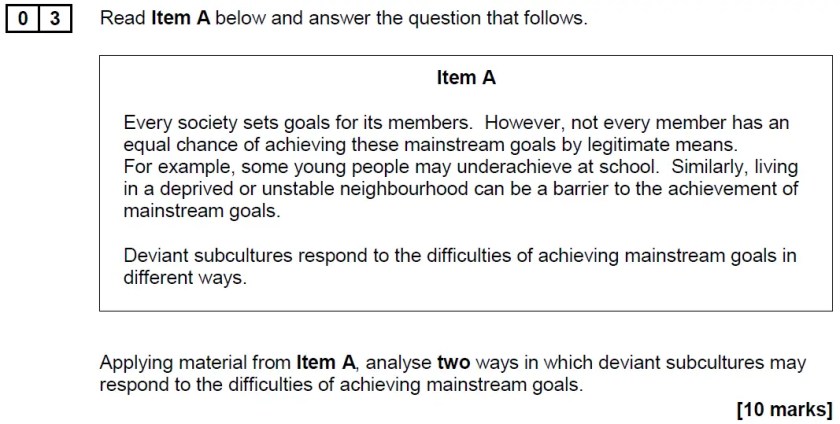Below is an example of an abbreviated (by me) marked response to the 20 mark theory essay which came up in the 2017 A-level sociology paper.
The specific question under investigation in this case is: ‘Applying material from Item C and your knowledge, evaluate the view that conflict approaches are more useful than consensus approaches to our understanding of society’ (20).
For general advice about how to answer the whole of paper three please see this post on ‘the 2017 crime and deviance with theory and methods’ paper.
The example is taken from the 2017 Education with Theory and Methods Paper (paper and mark schemes available from the AQA website).
The Question with Item

The Mark Scheme (top band only)

Student Response:
Sociology is divided between conflict and consensus approaches. The former believe there is harmony in society because of shared values (Functionalists), the later believe society is not harmonious but based on a division between a dominant and subordinate group (Marxists/ Feminists)
Some sociologists argue conflict approaches are more useful than consensus approaches for understanding society – Marxists view society as a conflict between the Bourgeosie (ruling class) and proletariat. They argue there is no harmony because the former exploit the later to create profit and keep their businesses running. The proletariat feel frustrated and alienated because they don’t control the means of production and technological advancement means many are losing their jobs and being made redundant. This all serves the interests of the ruling class who look for new, innovative ways to increase their profits. Marxists argue that certain aspects of society which appear functional are simply a false consciousness – making it appear the Bourgeoisie care about their workers but in reality they don’t for example health and safety laws exist so the proletariat are fit to keep working. However, Marxism only looks at the economic contribution of society and argues that all other institutions are influenced by the economy. Yet many would disagree, arguing that the purpose of the family or religion is to provide comfort, not profit for the Bourgeoisie.
Moreover, labelling theory also argue that conflict approaches act as a better understanding to society than consensus approaches. As an action theory, it argues that if we believe that an event is real, then it will have real consequences. Therefor they look at labelling in society and how there is link between conflict and power (item C) – an individual is given a label in society which influences their behaviour. Becker found that if a student is labelled as deviant then they are more likely to underachieve in school because they accepted that label as a self-fulfilling prophecy. When labels are given from those in higher authority, then they become a master status and become a dominant feature of the individual, which can lead to a deviant career. This also happens with certain crimes – e.g. those with the drug label are more likely to have the crime and the label enforced. However, LT is criticized for not taking into account wider structural features of society such as how capitalism influences people’s behaviour.
However consensus theories are critical (repeats question)… they argue societies are based on shared values and value consensus which allows institutions to harmoniously work together (item C). Parsons argues that this is because of functional prerequisites. Firstly there is economic adaptation to society to meet the economic needs of members, there is goal attainment where society create goals and allocates resources to these goals – the role of government. Then there is integration so the different institutions can meet share goals – the media, education, religion. Finally there is latency where the family socialises individuals into shared norms that society needs: instrumental and expressive role. Thus society hasn’t collapsed because it has a shared value system.
However, functionalism is criticised by postmodernists because it has an absolutist view of society as being functional for all. It neglects the fact that society is fragmented and diverse and the rise of different social movements like black lives matter or Feminism contradict the view that individuals form cohesive communities.
In conclusion it seems Functionalism as a consensus theory has relatively good ideas… for example that social change in society is a result of increasing complexity of society and to ensure that society doesn’t move into a state of anomie so equilibrium occur, different bits of society adapting to compensate.
However conflict theory seems more useful in understanding our society where there is complexity and no longer individuals who follow the same norms and values but rather join different groups which enhance their individual personal beliefs.
Examiner Commentary:
Well, at least one student’s been paying attention for the last couple of years!
Mark: 20/20
Signposting
This post has primarily been written to help students revise for their A-level sociology exams.
For more revision help please see this page: Exams, essays and Short Answer Questions.
This is a similar question applied to Crime: Evaluate Consensus Theories of Crime.
Please click here to return to the homepage – ReviseSociology.com
Sources:
A-level
SOCIOLOGY
Feedback on the Examinations
Student responses and commentaries: Paper 1 7192/3 Crime and Deviance with Theory and Methods
Published: Autumn 2017








 If you like this sort of thing, then you might like my Theory and Methods Revision Bundle – specifically designed to get students through the theory and methods sections of A level sociology papers 1 and 3.
If you like this sort of thing, then you might like my Theory and Methods Revision Bundle – specifically designed to get students through the theory and methods sections of A level sociology papers 1 and 3.